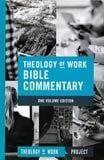Known Need: Faith and Work in Wendell Berry’s Fiction
Blog / Produced by The High Calling
From very early in my professional career, both in and out of professional ministry, I have struggled to connect my faith and my work. That clash in consciousness may have been what drew me to Wendell Berry’s 2012 short story “A Desirable Woman” and helped me relate to directly to its heroine, Laura Milby, the wife of a young preacher in fictional Sycamore.
“For nearly the whole congregation, or for all of them, and especially the men and children, there was a disconnection between the little white clapboard church with its steeple and bell, its observances and forms of worship, and the world’s daily life and work. . . . Laura recognized these disconnections in the people because she felt them, and labored over them, in herself,” Berry wrote.
This disconnect between faith and work, though not the main theme, sets a poignant backdrop to Berry’s story about Laura Milby and her husband, Williams. This town that separates its work from its worship also keeps its distance from its church—and the new young preacher and his wife—except in times of suffering.
“And when, having done all he could do to help a family through a quarrel or an illness or a death, performing services he was not paid for and could not have been paid for, he might never hear from them again, let alone see their faces even for the courtesy of one Sunday among his hearers, Laura felt herself wounded with sorrow for him and anger at them for their ingratitude.”
As a young woman working at a church several years ago, I, too, poured my heart into my ministry, often feeling this same distance from and frustration with the very people I served because I knew so little about their lives and the work they did when we weren’t together. Although we all met together at my workplace on Sunday, what I did in that church building on Monday through Saturday was just as foreign to them as what they did in their workplaces was to me.
In Berry’s story, this workplace divide is bridged through a ritual called “feeding the preacher” in which Williams Milby and his wife, Laura, were hosted for Sunday dinner and supper by members of the congregation on rotating Sundays.
Because the congregation experienced no real link between their daily lives and their faith, the time between the two Sunday meals with young Reverend Milby and his wife often afforded an awkward stretch of stunted conversation, especially during the winter months when they were stuck in the house. But if the Milbys could convince their hosts to show them something outside, which for most of the congregants was the realm of their work, the awkwardness dissipated. In this way, the Milbys themselves emerged as the bridge between faith and work for their people.
“On those Sunday afternoons in their unending sequence, when the weather was fit and sometimes when it was not, the Milbys followed their guides through barns and lots, fields and woods, and along the wild streamsides. They were shown flower beds, gardens, crops, and animals in all stages of the year. Within a year or two they came into intimate geography and life and worklife of the place.”
While at the High Calling we seek to help readers find God in their work, family, and the broader culture, could it be that pastors and other church leaders can help the faith community with that search by not just meeting them in churches on Sundays, but also connecting with their congregations in their workplaces, seeking to understand the demands and rigors of the Monday through Saturday lives of those they lead?
At the end of the story, Laura Milby experiences a revelation about work and calling that transcends the secular/sacred divide, and it happens while at the home of family friends, when she goes to the barn and finds a young man she has gotten to know. As she watches the man tending a baby lamb, she not only understands the work of the farmer and the work of those in her community, she also understands better the work her husband does.
“He had lifted from a nearby pen an orphan lamb and was holding it, its long legs dangling, in one hand, a nippled bottle of cow’s milk in the other. And suddenly she was filled with knowledge of him that was like love, or was love. In him, as he stood before her then, she saw the ancient unthanked care of shepherds. The sheep merely suffered what was to be suffered, living the given life, dying the given death. They did not ask for care or appreciate it when they received it. And yet the care was given. The flocks throve by no care commensurate with a price, but by an overplus of love, filling a known need in the shepherd, passionate and beyond memory old.”
Maybe in the end, it is our work and and its call on us that connect us rather than separate us. In helping each other fulfill our need to work, we learn how to truly worship.
Wendell Berry’s “A Desirable Woman” appears in A Place in Time: Twenty Stories of the Port William Membership, published in 2012 by Counterpoint Press.
Image by Jack Hynes. Used with permission. Sourced via Flickr. Post by High Calling Content Editor, Charity Singleton Craig.
Further Reading on the connection of work and faith:
- Calling All Christians by Skye Jethani
- Vocation as Parish: The Missional Possibilities of Inhabiting Your Workplace by Andy Campbell
- The Bigger Picture by Jay Halley





